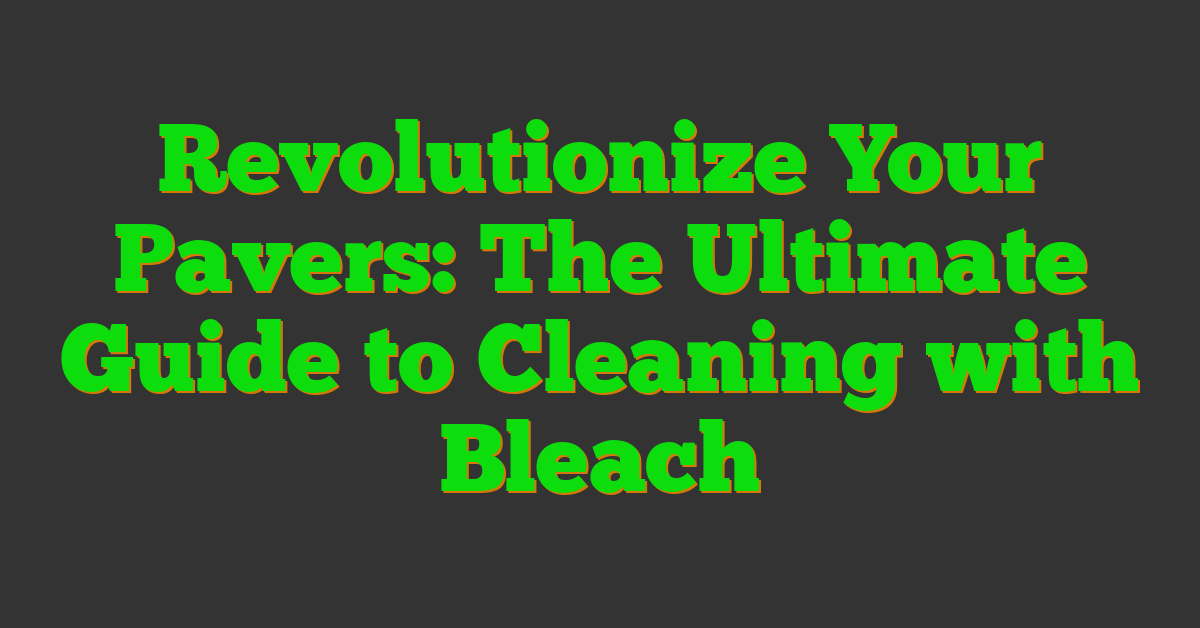If you’re looking to revitalize your outdoor space and bring back the sparkle to your pavers, using bleach could be the solution you’ve been searching for. Cleaning pavers with bleach is a cost-effective and efficient way to remove stubborn stains, mold, and mildew, giving your patio or walkway a fresh new look.

In our upcoming article, we’ll guide you through the step-by-step process of cleaning pavers with bleach, sharing tips and tricks to ensure a successful outcome. From preparing the bleach solution to applying it on the pavers, we’ve got you covered with all the information you need to tackle this project like a pro.
Join us as we explore the transformative power of bleach in rejuvenating your outdoor surfaces, making them look as good as new. Let’s dive into the world of paver cleaning with bleach and discover how easy it can be to achieve stunning results.
Evaluating the Safety and Effectiveness of Bleach for Paver Cleaning
Understanding the Risks
When considering using bleach for cleaning pavers, it’s crucial to understand the potential risks associated with this powerful cleaning agent. While bleach is effective in removing stains, mold, and mildew from pavers, it can also pose some risks.
One primary risk to be aware of is the potential for discoloration. Bleach is a strong chemical that can alter the color of your pavers, especially if not diluted correctly or if left on the surface for too long. This discoloration can affect the overall aesthetic of your outdoor space and may require additional steps to remedy.
Another risk to consider is the environmental impact of using bleach. As a harsh chemical, bleach can be harmful to surrounding plant life, grass, and the ecosystem in general. Proper care must be taken to minimize runoff and ensure that any residual bleach is safely and thoroughly rinsed away to prevent environmental damage.
Evaluating the Cleaning Power
Despite the risks involved, bleach remains a popular choice for cleaning pavers due to its exceptional cleaning power. Bleach can effectively tackle tough stains, mold, and mildew that may have accumulated on your pavers over time, restoring them to their original condition.
The key to harnessing the cleaning power of bleach while minimizing risks lies in proper application and dilution. Diluting bleach with water in the correct proportions and following recommended cleaning techniques can help ensure that your pavers are cleaned effectively without causing unnecessary damage.
When evaluating the cleaning power of bleach, it’s important to consider the type of stains you’re dealing with and the condition of your pavers. Tough stains may require a more concentrated bleach solution or additional cleaning steps to achieve the desired results.
By understanding both the risks and benefits of using bleach for paver cleaning, you can make an informed decision on whether it’s the right choice for rejuvenating your outdoor space. Remember to exercise caution, follow recommended guidelines, and always test a small, inconspicuous area before proceeding with full-scale cleaning.
Preparing to Clean Pavers with Bleach
Gathering Necessary Supplies
When we prepare to clean pavers with bleach, we must ensure we have all the essential supplies at hand. First, we need bleach, preferably a concentrated formula for effective stain removal. Additionally, we require a bucket for dilution, a stiff brush or broom for scrubbing, and protective gear such as gloves and safety glasses to shield ourselves from potential splashes.
Safety Precautions Before You Start
Before we embark on cleaning our pavers with bleach, prioritizing safety measures is crucial. We must wear appropriate protective clothing, including long sleeves and pants, to safeguard our skin from direct contact with the bleach solution. It’s also essential to work in a well-ventilated area to minimize inhaling fumes. Furthermore, we need to ensure pets and children are kept away from the cleaning site to prevent accidental exposure. Taking these safety precautions will allow us to clean our pavers effectively while prioritizing our well-being.
Step-by-Step Guide to Cleaning Pavers with Bleach
Clearing the Area
Before we dive into the cleaning process, it’s essential to clear the area around the pavers. Remove any furniture, plants, or objects to ensure unrestricted access to the pavers. This step helps prevent bleach spillage on surrounding items and allows for a thorough cleaning without any hindrances.
Mixing the Cleaning Solution
To create an effective cleaning solution, we’ll need to mix bleach with water. It’s crucial to follow the recommended dilution ratios to avoid damaging the pavers or causing any unwanted discoloration. Typically, a mixture of one part bleach to ten parts water is suitable for cleaning pavers effectively. Ensure thorough mixing to guarantee a consistent solution for optimal results.
Applying Bleach to the Pavers
Carefully apply the bleach solution onto the pavers using a sprayer or a watering can. Work methodically, covering the entire surface evenly to ensure a uniform cleaning process. Be cautious not to oversaturate the pavers, as excessive bleach can lead to discoloration. A controlled application will help target stains, mold, and mildew without damaging the pavers.
Scrubbing and Spot Treatment
After applying the bleach solution, it’s time to scrub the pavers using a stiff brush to remove tough stains and dirt buildup. Focus on areas with visible stains or discoloration, giving them extra attention. For stubborn spots, consider spot treatment by applying a small amount of undiluted bleach directly on the affected areas. Scrub gently to avoid damaging the pavers while effectively removing deep-seated stains.
Rinsing and Observing Results
Once the scrubbing is complete, rinse the pavers thoroughly with clean water. Use a garden hose or a pressure washer to wash away the bleach residue and dirt, revealing clean and revitalized pavers. Take a moment to observe the results, noting any remaining stains that may require additional treatment. Allow the pavers to air dry completely to appreciate the transformation and assess the overall cleaning outcome.
By following these steps meticulously, we ensure a successful paver cleaning process with bleach, rejuvenating outdoor spaces and maintaining the beauty of pavers effectively. Remember to exercise caution, prioritize safety measures, and test a small area before proceeding with full-scale cleaning to achieve optimal results.
Maintenance Tips After Cleaning with Bleach
Preventing Future Stains and Algae Growth
After cleaning your pavers with bleach, it’s essential to take proactive steps to prevent future stains and algae growth. One effective way is to apply a quality paver sealer, which creates a protective barrier against dirt, oil, and water absorption. By sealing your pavers, you not only enhance their appearance but also make them easier to clean in the future. We recommend reapplying the sealer every 2-3 years for optimal protection.
« Unlock the Secrets: Ultimate Guide to Laying Pavers in Florida for Stunning Outdoor Spaces Unleashing the Ultimate Guide to Picking Pavers: Your Journey to Awe-Inspiring Outdoor Spaces Begins Here »
Regular Cleaning Practices
To maintain the cleanliness and longevity of your pavers after using bleach, incorporate regular cleaning practices into your routine. Sweep the surface frequently to remove debris and prevent buildup. Additionally, consider gentle washing with a mixture of mild soap and water every few weeks to prevent dirt and grime accumulation. By staying consistent with these practices, you can preserve the beauty and durability of your pavers over time.
Alternatives to Bleach for Eco-Friendly Cleaning
Natural Substitutes for Bleach
When it comes to environmentally friendly cleaning options, we always look for natural substitutes that are gentle on both pavers and the planet. One effective alternative to bleach is a mixture of white vinegar and water. This natural solution can help remove stains and algae without harsh chemicals. It’s important to dilute the vinegar properly to avoid damaging the pavers’ surface, typically using a ratio of 1 part vinegar to 9 parts water.
Another eco-friendly option we recommend is hydrogen peroxide. This versatile cleaner not only helps to clean pavers but also acts as a disinfectant. By combining hydrogen peroxide with water in equal parts, you can create a safe and effective cleaning solution that is gentle on the environment.
Commercial Eco-Friendly Cleaners
For those who prefer ready-made solutions, there are commercial eco-friendly cleaners available on the market. When choosing a product, we suggest looking for cleaners that are biodegradable and free from harsh chemicals. These cleaners are specifically formulated to be environmentally conscious while still being effective at removing stains and grime from pavers.
Some eco-friendly commercial cleaners contain plant-based ingredients that are safe for outdoor use. These cleaners are designed to break down dirt and organic matter without harming the surrounding vegetation. By opting for these eco-friendly products, we can ensure that our outdoor spaces stay clean while minimizing our impact on the environment.
Conclusion
In wrapping up our discussion on cleaning pavers with bleach, we’ve highlighted the importance of proper dilution and application techniques to achieve effective results. By following the step-by-step guide provided, you can restore the beauty of your outdoor space. Remember, post-cleaning maintenance, such as applying a paver sealer, is crucial for long-lasting cleanliness. Opting for eco-friendly alternatives like white vinegar or commercial biodegradable cleaners showcases our commitment to both cleanliness and environmental responsibility. With these insights, we can enjoy pristine pavers while making sustainable choices. Let’s continue to care for our outdoor areas with diligence and eco-consciousness.











